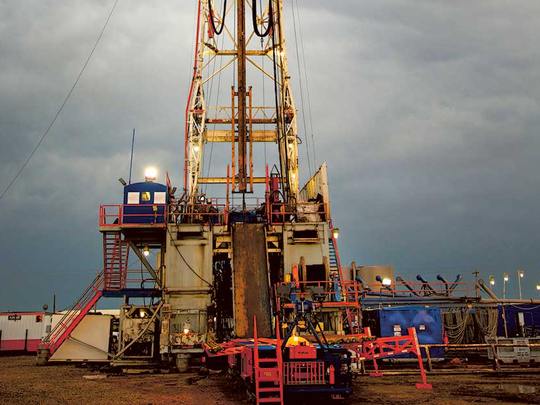
NEW YORK: Oil prices tumbled more than 1 per cent on Friday, extending losses after weekly industry data showed US drillers added rigs for only the second time this year.
Rigs targeting crude in the US rose by 9 to 325 last week, Baker Hughes Inc. said Friday. Explorers have idled more than 1,000 oil rigs since the start of last year. Natural gas rigs were trimmed by 5 to 82 last week, bringing the total for oil and gas up by 4 to 408.
The closely followed report rekindled fears that US shale drillers would turn the spigots back on as prices flirted with $50 a barrel. Prices had already dipped in early trade on worries about the US economy, but losses were limited by a weakening dollar, which makes oil less expensive for buyers using other currencies.
“The increase in the rig count as prices near the $50 barrel range is clearly indicative of the elasticity of US production and speaks to the tremendous efficiency gains reaped by the US producer community over recent years,” said Michael Tran, director of energy strategy at RBC Capital Markets in New York.
Oil traders view falling US output as key to reducing a global glut of crude that has pressured prices during a steep two-year slump.
Brent crude futures ended the session down 40 cents at $49.64 per barrel. Brent’s price remained almost double January lows, notching its eighth weekly gain in nine weeks.
US West Texas Intermediate (WTI) crude futures settled down 55 cents at $48.62. For the week, prices fell 1.1 per cent, its first weekly decline in four weeks.
“The uptick for rigs might have prompted some people to think that there’s a supply side reaction to $50 oil,” said Tim Evans, an energy analyst at Citi Futures Perspective in New York. “This is just one week’s data. This doesn’t change the fact that the rig count is down a great deal or represent the beginning of a recovery.”
The worst downturn in decades led oil producers to scrap projects and cut spending on drilling, signalling that supply and demand are getting close to being in balance. Disruptions in Canada and Nigeria took 50 million barrels out of the market last month, Geneva-based trading house Mercuria Energy Group Ltd. estimated.
Faster Rebalancing
“The rebalancing is happening a bit faster than anticipated because of the disruptions,” Mercuria Chief Executive Officer Marco Dunand said in an interview. “Demand is also stronger than expected” in countries from India to the US, he said.
The International Energy Agency forecasts oil demand will increase this year by 1.2 million barrels a day, while Dunand said growth is likely to top 1.5 million, perhaps rising as high as 1.8 million.
America’s oil drillers have been idling rigs since October 2014 as the world’s largest crude suppliers battle for market share. Despite the cutbacks, US production has only recently begun to falter as new techniques that increase efficiency keep the oil flowing.
US output declined for a 12th week and crude stockpiles dropped in the week ended May 27, according to a report from the Energy Information Administration.












